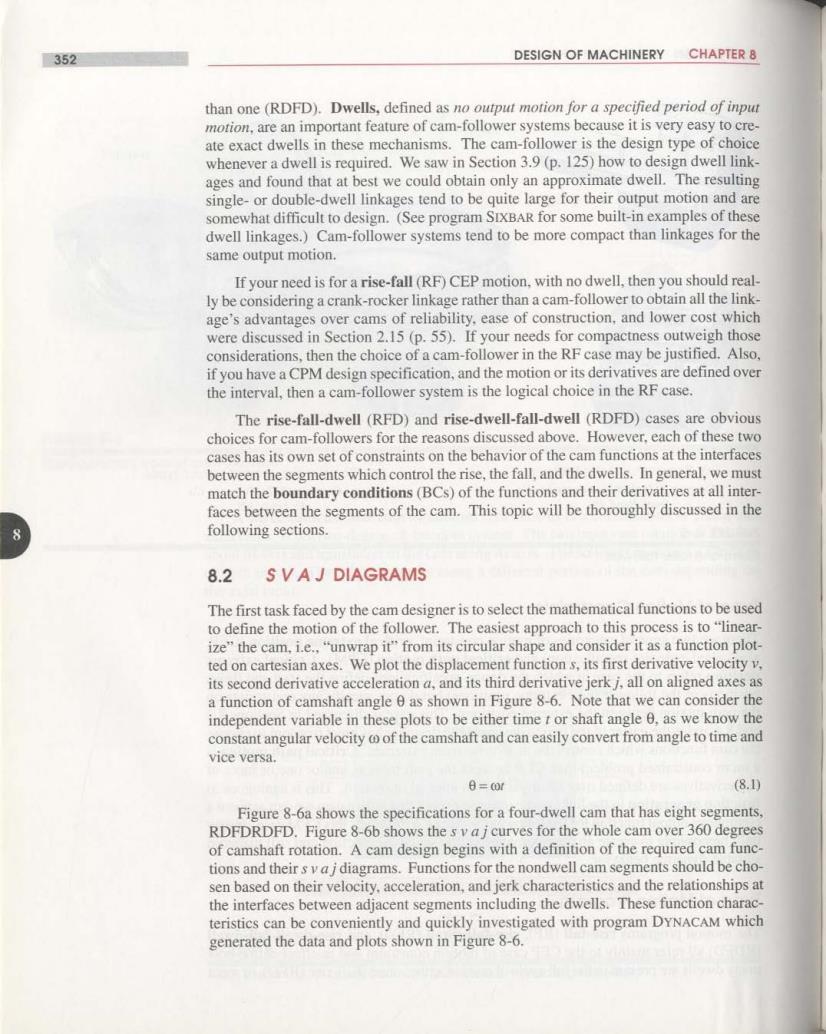正在加载图片...

352 DESIGN OF MACHINERY CHAPTER 8 than one (RDFD).Dwells,defined as no output motion for a specified period of input motion,are an important feature of cam-follower systems because it is very easy to cre- ate exact dwells in these mechanisms.The cam-follower is the design type of choice whenever a dwell is required.We saw in Section 3.9(p.125)how to design dwell link- ages and found that at best we could obtain only an approximate dwell.The resulting single-or double-dwell linkages tend to be quite large for their output motion and are somewhat difficult to design.(See program SIXBAR for some built-in examples of these dwell linkages.)Cam-follower systems tend to be more compact than linkages for the same output motion. If your need is for a rise-fall(RF)CEP motion,with no dwell,then you should real- ly be considering a crank-rocker linkage rather than a cam-follower to obtain all the link- age's advantages over cams of reliability.ease of construction,and lower cost which were discussed in Section 2.15(p.55).If your needs for compactness outweigh those considerations,then the choice of a cam-follower in the RF case may be justified.Also, if you have a CPM design specification,and the motion or its derivatives are defined over the interval,then a cam-follower system is the logical choice in the RF case. The rise-fall-dwell(RFD)and rise-dwell-fall-dwell(RDFD)cases are obvious choices for cam-followers for the reasons discussed above.However,each of these two cases has its own set of constraints on the behavior of the cam functions at the interfaces between the segments which control the rise,the fall,and the dwells.In general,we must match the boundary conditions(BCs)of the functions and their derivatives at all inter- faces between the segments of the cam.This topic will be thoroughly discussed in the following sections. 8.2 SVAJ DIAGRAMS The first task faced by the cam designer is to select the mathematical functions to be used to define the motion of the follower.The easiest approach to this process is to"linear- ize"the cam,i.e.,"unwrap it"from its circular shape and consider it as a function plot- ted on cartesian axes.We plot the displacement function s,its first derivative velocity v. its second derivative acceleration a,and its third derivative jerk j,all on aligned axes as a function of camshaft angle 0 as shown in Figure 8-6.Note that we can consider the independent variable in these plots to be either time t or shaft angle 0,as we know the constant angular velocity c of the camshaft and can easily convert from angle to time and vice versa. 6=0t (8.0 Figure 8-6a shows the specifications for a four-dwell cam that has eight segments, RDFDRDFD.Figure 8-6b shows the svajcurves for the whole cam over 360 degrees of camshaft rotation.A cam design begins with a definition of the required cam func- tions and their s va jdiagrams.Functions for the nondwell cam segments should be cho- sen based on their velocity,acceleration,and jerk characteristics and the relationships at the interfaces between adjacent segments including the dwells.These function charac- teristics can be conveniently and quickly investigated with program DYNACAM which generated the data and plots shown in Figure 8-6